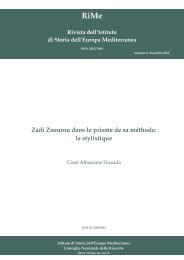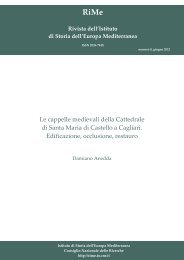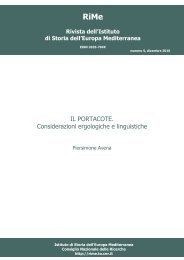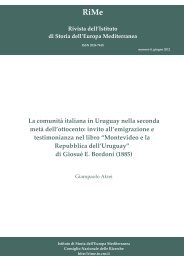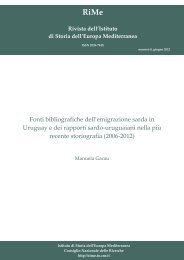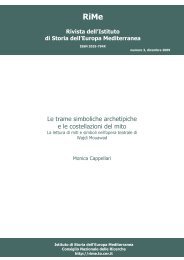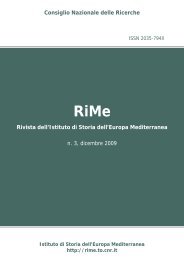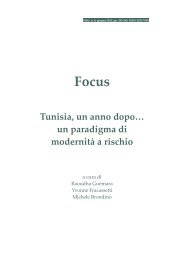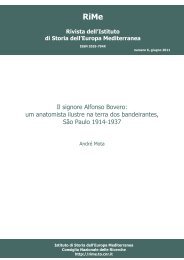- Page 1 and 2:
Consiglio Nazionale delle Ricerche
- Page 3 and 4:
RiMe, n. 9, dicembre 2012, 321 p. I
- Page 5 and 6:
RiMe, n. 9, dicembre 2012, pp. 5‐
- Page 7 and 8:
RiMe, n. 9, dicembre 2012, pp. 5‐
- Page 9 and 10:
RiMe, n. 9, dicembre 2012, pp. 5‐
- Page 11 and 12:
RiMe, n. 9, dicembre 2012, pp. 5‐
- Page 13 and 14:
RiMe, n. 9, dicembre 2012, pp. 5‐
- Page 15 and 16:
RiMe, n. 9, dicembre 2012, pp. 5‐
- Page 17 and 18:
RiMe, n. 9, dicembre 2012, pp. 5‐
- Page 19 and 20:
RiMe, n. 9, dicembre 2012, pp. 5‐
- Page 21 and 22:
RiMe, n. 9, dicembre 2012, pp. 5‐
- Page 23 and 24:
RiMe, n. 9, dicembre 2012, pp. 5‐
- Page 25 and 26:
RiMe, n. 9, dicembre 2012, pp. 5‐
- Page 27 and 28:
RiMe, n. 9, dicembre 2012, pp. 5‐
- Page 29 and 30:
RiMe, n. 9, dicembre 2012, pp. 5‐
- Page 31 and 32:
RiMe, n. 9, dicembre 2012, pp. 5‐
- Page 33 and 34:
RiMe, n. 9, dicembre 2012, pp. 5‐
- Page 35 and 36:
RiMe, n. 9, dicembre 2012, pp. 5‐
- Page 37 and 38:
RiMe, n. 9, dicembre 2012, pp. 5‐
- Page 39 and 40:
RiMe, n. 9, dicembre 2012, pp. 5‐
- Page 41 and 42:
RiMe, n. 9, dicembre 2012, pp. 5‐
- Page 43 and 44:
RiMe, n. 9, dicembre 2012, pp. 43
- Page 45 and 46:
RiMe, n. 9, dicembre 2012, pp. 43
- Page 47 and 48:
RiMe, n. 9, dicembre 2012, pp. 43
- Page 49 and 50:
RiMe, n. 9, dicembre 2012, pp. 43
- Page 51 and 52:
RiMe, n. 9, dicembre 2012, pp. 43
- Page 53 and 54:
RiMe, n. 9, dicembre 2012, pp. 43
- Page 55 and 56:
Bibliografia RiMe, n. 9, dicembre 2
- Page 57 and 58:
RiMe, n. 9, dicembre 2012, pp. 57
- Page 59 and 60:
RiMe, n. 9, dicembre 2012, pp. 57
- Page 61 and 62:
RiMe, n. 9, dicembre 2012, pp. 57
- Page 63 and 64:
RiMe, n. 9, dicembre 2012, pp. 57
- Page 65 and 66:
RiMe, n. 9, dicembre 2012, pp. 57
- Page 67 and 68:
RiMe, n. 9, dicembre 2012, pp. 57
- Page 69 and 70:
RiMe, n. 9, dicembre 2012, pp. 57
- Page 71 and 72:
RiMe, n. 9, dicembre 2012, pp. 57
- Page 73 and 74:
RiMe, n. 9, dicembre 2012, pp. 57
- Page 75 and 76:
RiMe, n. 9, dicembre 2012, pp. 57
- Page 77 and 78:
RiMe, n. 9, dicembre 2012, pp. 57
- Page 79:
RiMe, n. 9, dicembre 2012, pp. 57
- Page 82 and 83:
Valeria Deplano sione, di fungere d
- Page 84 and 85:
Valeria Deplano re e realizzare le
- Page 86 and 87:
Valeria Deplano nasca lʹIstituto c
- Page 88 and 89:
Valeria Deplano ro fede, non siano
- Page 90 and 91:
Valeria Deplano nuovo consiglio dir
- Page 92 and 93:
Valeria Deplano si sono rivelate in
- Page 94 and 95:
Valeria Deplano paganda relativi ai
- Page 96 and 97:
Valeria Deplano fondire lo studio e
- Page 98 and 99:
Valeria Deplano nazionali, che in P
- Page 100 and 101: Valeria Deplano Il dibattito proseg
- Page 102 and 103: Valeria Deplano aumentare nuovament
- Page 104 and 105: Valeria Deplano lopiù studiare sul
- Page 106 and 107: Valeria Deplano che dal 1939 la Soc
- Page 108 and 109: Valeria Deplano reciproca importanz
- Page 110 and 111: Valeria Deplano Roma, Meltemi edito
- Page 113 and 114: RiMe, n. 9, dicembre 2012, pp. 113
- Page 115 and 116: RiMe, n. 8, dicembre 2012, pp. 113
- Page 117 and 118: RiMe, n. 8, dicembre 2012, pp. 113
- Page 119 and 120: RiMe, n. 8, dicembre 2012, pp. 113
- Page 121 and 122: RiMe, n. 8, dicembre 2012, pp. 113
- Page 123 and 124: RiMe, n. 8, dicembre 2012, pp. 113
- Page 125 and 126: RiMe, n. 8, dicembre 2012, pp. 113
- Page 127 and 128: RiMe, n. 8, dicembre 2012, pp. 113
- Page 129 and 130: RiMe, n. 8, dicembre 2012, pp. 113
- Page 131: RiMe, n. 8, dicembre 2012, pp. 113
- Page 135 and 136: RiMe, n. 9, dicembre 2012, pp. 135
- Page 137 and 138: RiMe, n. 9, dicembre 2012, pp. 135
- Page 139 and 140: RiMe, n. 9, dicembre 2012, pp. 135
- Page 141: RiMe, n. 9, dicembre 2012, pp. 135
- Page 145 and 146: un L’homme‐initiateur Entendre
- Page 147 and 148: en moi les plumes légères du vent
- Page 149: RiMe, n.9, dicembre 2012, pp. 145
- Page 153 and 154: RiMe, n. 9, dicembre 2012, pp. 151
- Page 155 and 156: RiMe, n. 9, dicembre 2012, pp. 151
- Page 157 and 158: RiMe, n. 9, dicembre 2012, pp. 151
- Page 159 and 160: RiMe, n. 9, dicembre 2012, pp. 151
- Page 161: RiMe, n. 9, dicembre 2012, pp. 151
- Page 164 and 165: Valy Sidibé Introduction L’analy
- Page 166 and 167: Valy Sidibé clairement exprimée p
- Page 168 and 169: Valy Sidibé dramaturgique, puise t
- Page 170 and 171: Valy Sidibé (…) l’humanité, q
- Page 172 and 173: Valy Sidibé Scherer, Jacques. Le T
- Page 174 and 175: François Atsain N’cho Si la prob
- Page 176 and 177: François Atsain N’cho 1. La litt
- Page 178 and 179: François Atsain N’cho d’échec
- Page 180 and 181: François Atsain N’cho Le texte,
- Page 182 and 183: François Atsain N’cho ces de son
- Page 184 and 185: François Atsain N’cho tonalité
- Page 186 and 187: François Atsain N’cho Dazô Wueu
- Page 188 and 189: François Atsain N’cho mais ses c
- Page 190 and 191: François Atsain N’cho tualité l
- Page 192 and 193: François Atsain N’cho Man Jusu,
- Page 194 and 195: Logbo Blédé peut renvoyer à des
- Page 196 and 197: Logbo Blédé des symboles qui rapp
- Page 198 and 199: Logbo Blédé pouvoir, sa parole sc
- Page 200 and 201:
Logbo Blédé Ceux de droite sont m
- Page 202 and 203:
Logbo Blédé et plaquée d’amule
- Page 205 and 206:
RiMe, n. 9, dicembre 2012, pp. 205
- Page 207 and 208:
RiMe, n. 9, dicembre 2012, pp. 205
- Page 209 and 210:
RiMe, n. 9, dicembre 2012, pp. 205
- Page 211 and 212:
RiMe, n. 9, dicembre 2012, pp. 205
- Page 213 and 214:
RiMe, n. 9, dicembre 2012, pp. 205
- Page 215 and 216:
RiMe, n. 9, dicembre 2012, pp. 205
- Page 217 and 218:
RiMe, n. 9, dicembre 2012, pp. 217
- Page 219 and 220:
RiMe, n. 9, dicembre 2012, pp. 217
- Page 221 and 222:
le continue dans ses profondeurs co
- Page 223 and 224:
RiMe, n. 9, dicembre 2012, pp. 217
- Page 225 and 226:
RiMe, n. 9, dicembre 2012, pp. 217
- Page 227 and 228:
RiMe, n. 9, dicembre 2012, pp. 217
- Page 229 and 230:
RiMe, n. 9, dicembre 2012, pp. 229
- Page 231 and 232:
RiMe, n. 9, dicembre 2012, pp. 229
- Page 233 and 234:
Dard insoupçonné des sentiers dé
- Page 235 and 236:
RiMe, n. 9, dicembre 2012, pp. 229
- Page 237 and 238:
RiMe, n. 9, dicembre 2012, pp. 229
- Page 239 and 240:
RiMe, n. 9, dicembre 2012, pp. 229
- Page 241 and 242:
RiMe, n. 9, dicembre 2012, pp. 229
- Page 243:
RiMe, n. 9, dicembre 2012, pp. 229
- Page 246 and 247:
Aboubakar Ouattara Introduction 3 N
- Page 248 and 249:
Aboubakar Ouattara dont le Verbe‐
- Page 250 and 251:
Aboubakar Ouattara ‐ autocréateu
- Page 252 and 253:
Aboubakar Ouattara d’existence. L
- Page 254 and 255:
Aboubakar Ouattara culturelles mais
- Page 257 and 258:
RiMe, n. 9, dicembre 2012, pp. 257
- Page 259 and 260:
RiMe, n. 9, dicembre 2012, pp. 257
- Page 261 and 262:
RiMe, n. 9, dicembre 2012, pp. 257
- Page 263 and 264:
RiMe, n. 9, dicembre 2012, pp. 257
- Page 265 and 266:
RiMe, n. 9, dicembre 2012, pp. 257
- Page 267 and 268:
C’est le bal à MONTEGOBE C’est
- Page 269 and 270:
RiMe, n. 9, dicembre 2012, pp. 257
- Page 271 and 272:
RiMe, n. 9, dicembre 2012, pp. 257
- Page 273 and 274:
RiMe, n. 9, dicembre 2012, pp. 257
- Page 275:
RiMe, n. 9, dicembre 2012, pp. 257
- Page 278 and 279:
Nanourougo Coulibaly mension non en
- Page 280 and 281:
Nanourougo Coulibaly 1.1. Identité
- Page 282 and 283:
Nanourougo Coulibaly de la langue s
- Page 284 and 285:
Nanourougo Coulibaly festent dans l
- Page 286 and 287:
Nanourougo Coulibaly 2.1.2. L’all
- Page 288 and 289:
Nanourougo Coulibaly 2.1.4. La voix
- Page 290 and 291:
Nanourougo Coulibaly C’est ce que
- Page 292 and 293:
Nanourougo Coulibaly fut‐elle cel
- Page 294 and 295:
Nanourougo Coulibaly discursive. En
- Page 296 and 297:
Nanourougo Coulibaly ses lecteurs e
- Page 299 and 300:
RiMe, n. 9, dicembre 2012, pp. 299
- Page 301 and 302:
RiMe, n. 9, dicembre 2012, pp. 299
- Page 303 and 304:
RiMe, n. 9, dicembre 2012, pp. 299
- Page 305 and 306:
RiMe, n. 9, dicembre 2012, pp. 299
- Page 307 and 308:
RiMe, n. 9, dicembre 2012, pp. 307
- Page 309 and 310:
RiMe, n. 9, dicembre 2012, pp. 307
- Page 311 and 312:
RiMe, n. 9, dicembre 2012, pp. 307
- Page 313 and 314:
RiMe, n. 9, dicembre 2012, pp. 307
- Page 315 and 316:
RiMe, n. 9, dicembre 2012, pp. 307
- Page 317 and 318:
RiMe, n. 9, dicembre 2012, pp. 307
- Page 319 and 320:
RiMe, n. 9, dicembre 2012, pp. 307
- Page 321 and 322:
RiMe, n. 9, dicembre 2012, pp. 307





